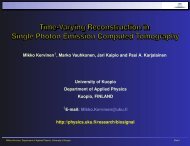USER'S GUIDE - Biosignal Analysis and Medical Imaging Group
USER'S GUIDE - Biosignal Analysis and Medical Imaging Group
USER'S GUIDE - Biosignal Analysis and Medical Imaging Group
- No tags were found...
Create successful ePaper yourself
Turn your PDF publications into a flip-book with our unique Google optimized e-Paper software.
2.1. Heart beat period <strong>and</strong> QRS detection 17VasomotorsympatheticTPRSympatheticSympatheticSympatheticΔV vVCHR+Left ventricleHEARTV s× CO BPa×VagalHRBaroreceptorsFigure 2.1: The four baroreflex pathways (redrawn from [41]). Variation in venous volume(ΔV v ), left ventricular contractility (VC), sympathetic <strong>and</strong> parasympathetic (vagal) controlof heart rate (HR), stroke volume (V s ), cardiac output (CO), total peripheral resistance(TPR), <strong>and</strong> arterial blood pressure (BP a ).time series, a fundamental issue is the determination of heart beat period.2.1 Heart beat period <strong>and</strong> QRS detectionThe aim in HRV analysis is to examine the sinus rhythm modulated by the autonomic nervoussystem. Therefore, one should technically detect the occurrence times of the SA-nodeaction potentials. This is, however, practically impossible <strong>and</strong>, thus, the fiducial points forthe heart beat is usually determined from the ECG recording. The nearest observable activityin the ECG compared to SA-node firing is the P-wave resulting from atrial depolarization(see Fig. 2.2) <strong>and</strong>, thus, the heart beat period is generally defined as the time differencebetween two successive P-waves. The signal-to-noise ratio of the P-wave is, however, clearlylower than that of the strong QRS complex which results primarily from ventricular depolarization.Therefore, the heart beat period is commonly evaluated as the time differencebetween the easily detectable QRS complexes.A typical QRS detector consists of a preprocessing part followed by a decision rule.Several different QRS detectors have been proposed within last decades [45, 34, 35, 16, 11].For an easy to read review of these methods, see [1]. The preprocessing of the ECG usuallyincludes at least b<strong>and</strong>pass filtering to reduce power line noise, baseline w<strong>and</strong>er, muscle noise,<strong>and</strong> other interference components. The passb<strong>and</strong> can be set to approximately 5–30 Hzwhich covers most of the frequency content of QRS complex [34]. In addition, preprocessingcan include differentiation <strong>and</strong>/or squaring of the samples. After preprocessing, the decisionrules are applied to determine whether or not a QRS complex has occurred. The decisionrule usually includes an amplitude threshold which is adjusted adaptively as the detectionprogresses. In addition, the average heart beat period is often used in the decision. Thefiducial point is generally selected to be the R-wave <strong>and</strong> the corresponding time instants aregiven as the output of the detector.The accuracy of the R-wave occurrence time estimates is often required to be 1–2 ms<strong>and</strong>, thus, the sampling frequency of the ECG should be at least 500–1000 Hz [44]. If theKubios HRV <strong>Analysis</strong>version 2.0 beta<strong>Biosignal</strong> <strong>Analysis</strong> <strong>and</strong> <strong>Medical</strong> <strong>Imaging</strong> <strong>Group</strong>Department of PhysicsUniversity of Kuopio, FINLAND





